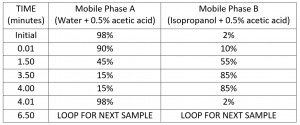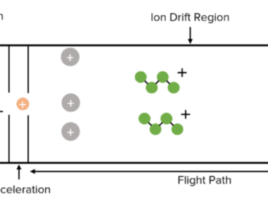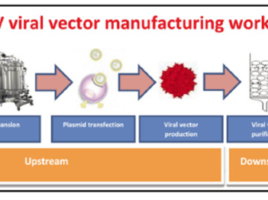MYCOTOXIN ASSAY
This assay was performed by Shimadzu (1), the manufacturer of the equipment used, all information shown is from them unless otherwise stated.
Mycotoxins are severely toxic contaminants which can be found in grains, they’re naturally occurring and are produced by certain moulds found on food (fungi) and present a risk to human health. The most common are Aflatoxins and Ochratoxin A. The World Health Organisation set the maximum level for Aflatoxin in food at 0.5 – 15 µg/kg (2) and for Ochratoxin-A at 1 – 50 µg/mg for food and 100 – 1000 µg/kg for animal feed (3).
Due to the toxicity of Mycotoxins, the rapid determination of their presence is essential. UHPLC-MS/MS offers the best combination of selectivity, sensitivity, and speed for detecting these compounds in complex matrices. In this study (1), a high throughput method for the quantitation of 23 Mycotoxins in various matrices was established.
Method:
5g of dry food (such as grain or animal feed) was mixed with 10ml of water to produce the sample. 10g of wet food (such as fruit) produced the sample.
10ml Acetonitrile was added and the sample macerated, before salts were added to allow phase separation. The solution was then centrifuged to pellet the solids. The supernatant was transferred to a clean tube and 5 fold diluted with Mobile Phase A (Water + 0.5% acetic acid) and internal standard.
20 µl of the solution was injected onto the column using the gradient shown in Table 1 at a flow rate of 0.4ml / min.
This assay could be used for any type of food, and as the method is developed by the manufacturer on the exact machine, we can run this assay. If you have a similar project would like analysed, then please get in contact.
References
- Rapid simultaneous assay of 23 mycotoxines in a variety of food samples by UHPLC-MS/MS using fast polarity switching [Internet]. 2013 [cited 2 March 2020]. Available from: https://www.shimadzu.com/an/literature/lcms/fro113069.html
- Mycotoxins [Internet]. World Health Organisation. 2018 [cited 2 March 2020]. Available from: https://www.who.int/news-room/fact-sheets/detail/mycotoxins
- Egmond V. Worldwide regulations for Ochratoxin A [Internet]. 1991 [cited 2 March 2020]. Available from: https://www.ncbi.nlm.nih.gov/pubmed/1820350



